Halloween treat: Asteroid 2015 TB145 to flyby Earth at 1.3 LD on October 31
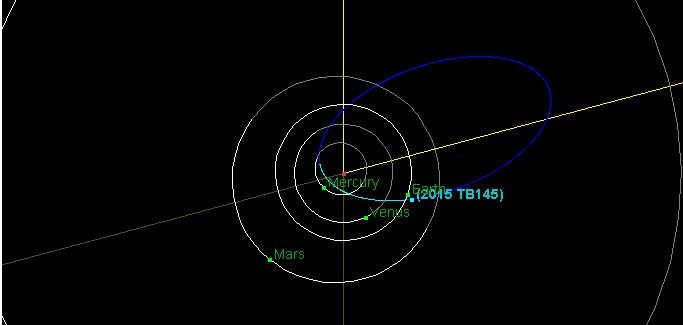
The newly discovered asteroid 2015 TB145 will flyby our planet at the closest approach distance of about 1.3 lunar distances at 17:05 UTC on October 31, 2015. NASA's scientists are closely monitoring the asteroid, dubbed the 'Halloween asteroid', with numerous optical observatories and radars of the agency's Deep Space Network at Goldstone, California.
2015 TB145 was discovered on October 10 by the University of Hawaii's Panoramic Survey Telescope and Rapid Response System (Pan-STARRS-1), as a part of the Near-Earth Object Observation (NEOO) Program. The object is expected to make the closest approach on the late UTC afternoon of October 31, when it will be located about 1.3 lunar distances (499 000 km or 310 000 miles) from Earth.
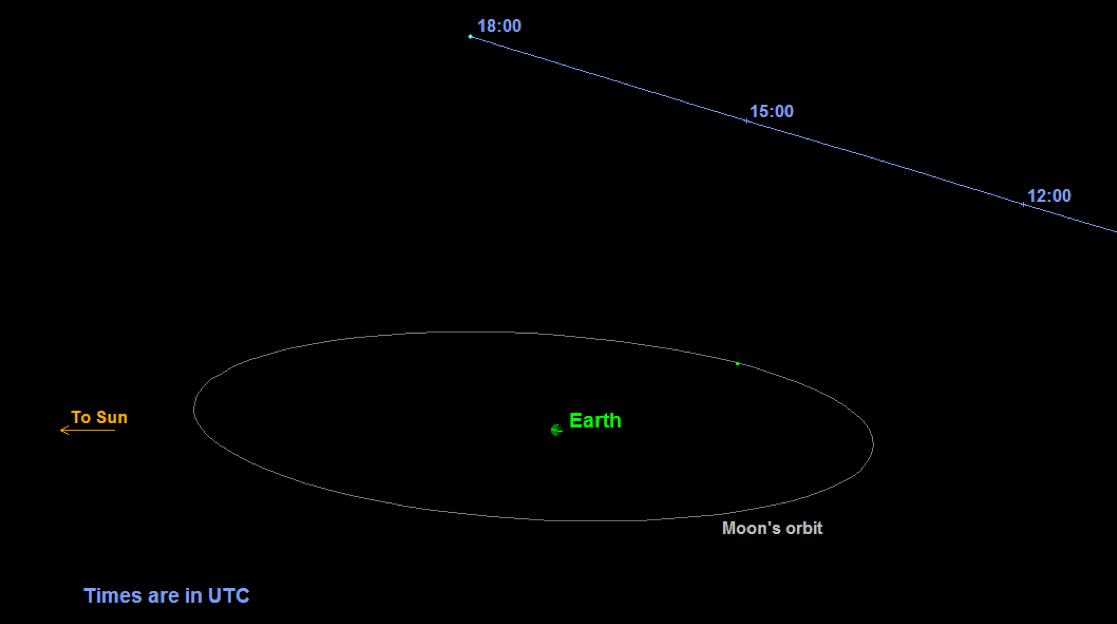
A graphic depiction the orbit of asteroid 2015 TB145. Image credit: P. Chodas (NASA/JPL – Caltech)
The asteroid is estimated to be about 400 meters (1 300 feet) wide with extremely high eccentricity values reaching 0.86 and an inclination angle of 40 º. Such an orbit suggest the asteroid could be of cometary nature.
"The asteroid's orbit is very oblong with a high inclination to below the plane of the solar system. Such a unique orbit, along with its high encounter velocity — about 35 kilometers or 22 miles per second — raises the question of whether it may be some type of comet. If so, then this would be the first time that the Goldstone radar has imaged a comet from such a close distance," said Lance Benner, of Jet Propulsion Laboratory (JPL), who leads NASA's asteroid radar research program.
According to the catalog of near-Earth objects (NEOs) kept by the Minor Planet Center, the approach of 2015 TB145 is currently the closest known approach of an object of this size until August 2027, when an 800 meters (2 600 feet) wide asteroid 1999 AN10 is expected to fly past our planet at 1 lunar distance (383 023 km or 238 000 miles).
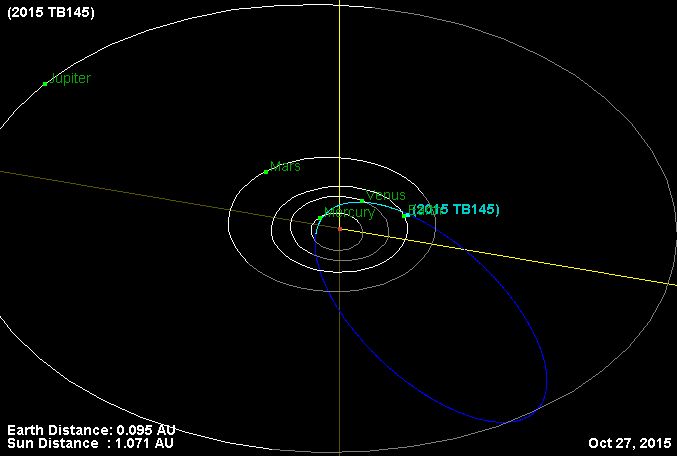
A graphic depiction of the 2015 TB145 orbit in perspective with the Solar System planets. Image credit: NASA/JPL – Caltech
"The trajectory of 2015 TB145 is well understood. At the point of closest approach, it will be no closer than about 300,000 miles – 480,000 kilometers or 1.3 lunar distances. Even though that is relatively close by celestial standards, it is expected to be fairly faint, so night-sky Earth observers would need at least a small telescope to view it,"said Paul Chodas, manager of the Center for Near Earth Object Studies at NASA's Jet Propulsion Laboratory, Pasadena, California.
Scientific opportunity target
The coming flyby event of 2015 TB145 is regarded as a scientific opportunity target, and it will be tracked and scanned by the most advanced instrumentation.
During tracking, scientists will use the 34-meter (110-foot) DSS 13 antenna at Goldstone to bounce radio waves off the asteroid. Radar echoes will in turn be collected by the National Radio Astronomy Observatory's Green Bank Telescope in Green Bank, West Virginia, and the National Astronomy and Ionosphere Center' Arecibo Observatory, Puerto Rico. NASA's researchers expect to gather radar images of the asteroid as fine as about 2 meters (7 feet) per pixel which has the potential to reveal important details about the object's surface features, shape, dimensions and other physical properties.
"The close approach of 2015 TB145 at about 1.3 times the distance of the moon's orbit, coupled with its size, suggests it will be one of the best asteroids for radar imaging we'll see for several years. We plan to test a new capability to obtain radar images with two-meter resolution for the first time and hope to see unprecedented levels of detail," said Lance Benner.
When observed from Earth, the asteroid will have a relative magnitude less than 10, which means it won't be visible to a naked eye. However, it could be observed with a reasonably good quality amateur telescope, as it crosses the Orion constellation on October 31.
In any case, this flyby could present an interesting opportunity for citizens astronomers around the globe to complement their Halloween plans, should the local weather be permitting!
Update, October 31
From NASA/JPL:
The large space rock that will zip past Earth this Halloween is most likely a dead comet that, fittingly, bears an eerie resemblance to a skull.
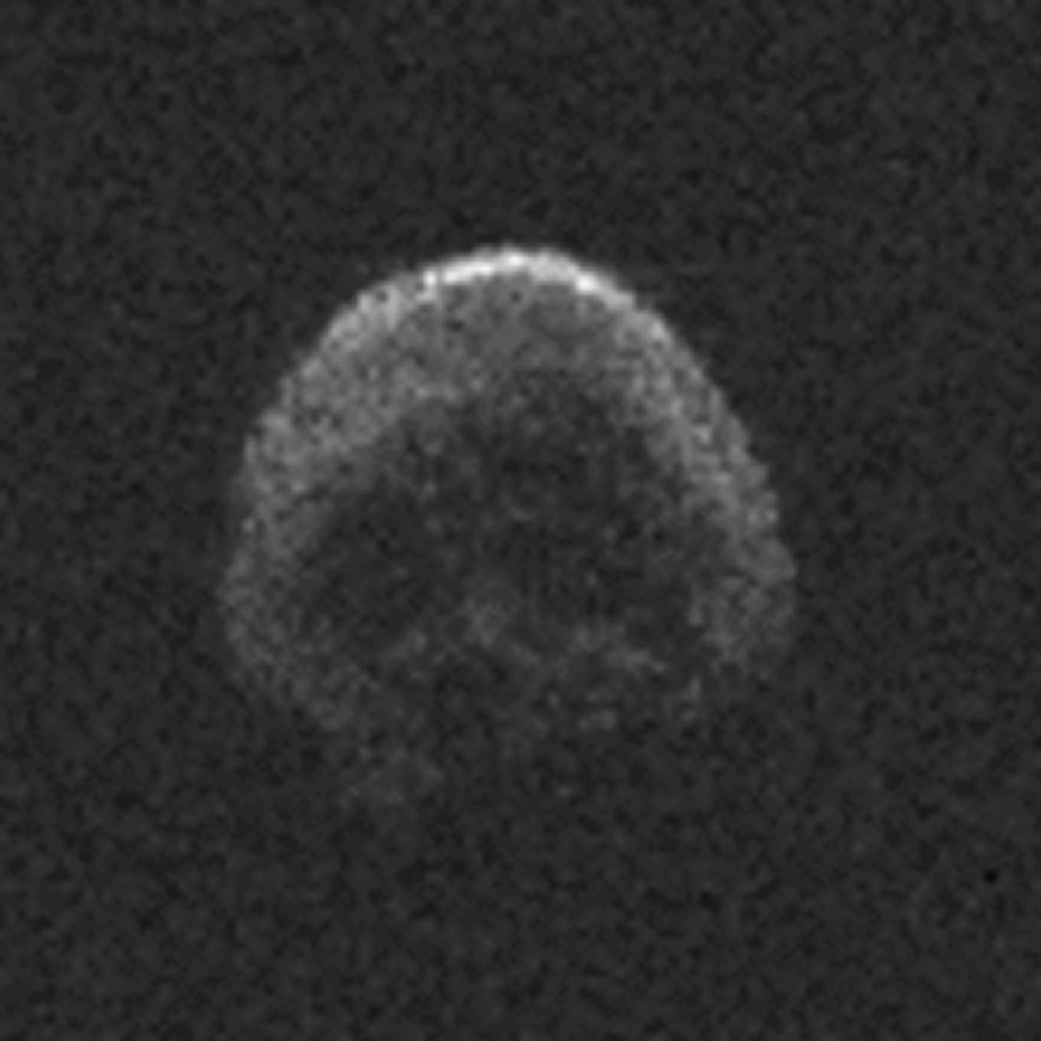
This image of asteroid 2015 TB145, a dead comet, was generated using radar data collected by the Arecibo Observatory in Puerto Rico. The radar image was taken on October 30, 2015, and the image resolution is 7.5 meters (25 feet) per pixel. Image credit: NAIC-Arecibo/NSF
Scientists observing asteroid 2015 TB145 with NASA's Infrared Telescope Facility (IRTF) on Mauna Kea, Hawaii, have determined that the celestial object is more than likely a dead comet that has shed its volatiles after numerous passes around the sun.
The belated comet has also been observed by optical and radar observatories around the world, providing even more data, including our first close-up views of its surface.
The first radar images of the dead comet were generated by the National Science Foundation's 305-meter (1 000-foot) Arecibo Observatory in Puerto Rico. The radar images from Arecibo indicate the object is spherical in shape and approximately 600 meters (2 000 feet) in diameter and completes a rotation about once every five hours.
"The IRTF data may indicate that the object might be a dead comet, but in the Arecibo images it appears to have donned a skull costume for its Halloween flyby," said Kelly Fast, IRTF program scientist at NASA Headquarters and acting program manager for NASA's NEO Observations Program.
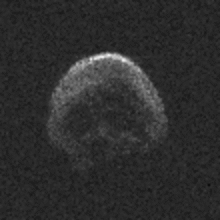
These first radar images from the Arecibo Observatory in Puerto Rico, indicate the near-Earth object is spherical in shape and approximately 600 meters (2 000 feet) in diameter. The radar images were taken on October 30, 2015, and the image resolution is 7.5 meters (25 feet) per pixel. Image credit: NAIC-Arecibo/NSF
Managed by the University of Hawaii for NASA, the IRTF's 3-meter (10 foot) telescope collected infrared data on the object. The data may finally put to rest the debate over whether 2015 TB145, with its unusual orbit, is an asteroid or is of cometary origin.
"We found that the object reflects about six percent of the light it receives from the sun," said Vishnu Reddy, a research scientist at the Planetary Science Institute, Tucson, Arizona. "That is similar to fresh asphalt, and while here on Earth we think that is pretty dark, it is brighter than a typical comet which reflects only 3 to 5 percent of the light. That suggests it could be cometary in origin – but as there is no coma evident, the conclusion is it is a dead comet."
Featured image: A graphic depiction of the 2015 TB145 orbit in perspective with the Solar System planets, October 27, 2015. Image credit: NASA/JPL-Caltech

have a live stream?